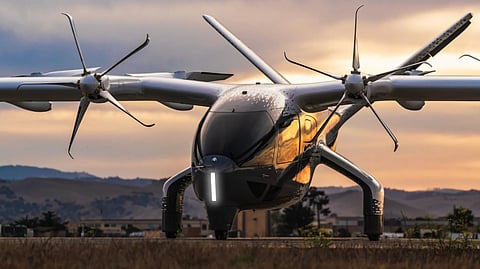When Will You Hail a Flying Uber?
The Billion-Dollar Race to Dominate the Luxury eVTOL Air Taxi Market
It sounds like science fiction: calling an app, stepping into a sleek electric aircraft, and lifting off vertically above Manhattan traffic. But for companies like Joby Aviation, Archer Aviation, and Vertical Aerospace, this is the billion-dollar race that could redefine the future of mobility. Uber first launched the idea with “Uber Elevate,” which was later acquired by Joby Aviation, and now the momentum is accelerating. Test flights have already taken place in California, Europe, and the Middle East, and regulatory agencies like the FAA and EASA are inching closer to approval frameworks.
Investors are betting big, with Goldman Sachs and Toyota backing Joby, while United Airlines has ordered 200 eVTOLs from Archer. These futuristic machines promise to cut two-hour commutes into 10-minute flights. Still, the luxury lifestyle question remains: will flying cars be a thrilling new playground for the ultra-rich, or the next wave of urban transportation for everyone?
Early eVTOL Flights Will Be Exclusive Experiences for the Wealthy Few
Although developers are framing eVTOLs as the next revolution in ridesharing, early adopters won’t be everyday commuters—they’ll be high-net-worth individuals. The cost of initial rides is projected between $200 and $400 for a 10–15 minute hop, comparable to private helicopter charters but marketed as more sustainable and efficient. These vehicles are designed with luxe details in mind: panoramic windows, whisper-quiet cabins, and interiors more reminiscent of business jets than taxi cabs.
For those who already travel by helicopter between Manhattan and JFK, the leap to an eVTOL isn’t so much about practicality as it is prestige. Think of it as the Tesla Roadster moment for aviation: a blend of exclusivity, sustainability promises, and futuristic design. Just as only a select few could afford the earliest luxury EVs, flying cars will begin as rarefied toys of the elite before they ever scale down to a wider market.
Luxury Skyports and Private Lounges Will Redefine City Travel
Flying cars aren’t just about the aircraft—they’re about the lifestyle ecosystem that surrounds them. Enter the skyport, the luxury infrastructure that will make urban air mobility possible. Companies are already partnering with real estate developers to design vertiports on skyscraper rooftops, marina docks, and even exclusive suburban estates. Picture this: a glass-and-steel sky lounge in Midtown Manhattan where passengers sip champagne while waiting for their personal flying car to whisk them away to the Hamptons in 20 minutes. Miami is preparing waterfront vertiports to serve private marinas, while Dubai plans integrated sky-lobbies in its newest luxury towers.
The experience will feel more like stepping into a members-only club than an airport terminal. For the ultra-wealthy, the appeal is not just skipping traffic—it’s the exclusivity of a seamless, branded journey where the flight is only one element of a carefully choreographed luxury lifestyle.
Are Electric Flying Cars Truly Eco-Luxury or Just Greenwashing?
A major selling point for eVTOLs is their promise of sustainability. Manufacturers tout zero-emission flights, quiet electric propulsion, and carbon-neutral travel as key benefits over traditional helicopters or private jets. But skeptics argue that this is a case of luxury greenwashing. While the vehicles themselves may not burn fossil fuel midair, the production of massive lithium-ion batteries, the energy required for charging infrastructure, and the short lifespan of current prototypes raise serious questions.
Can a 10-minute luxury hop really be considered environmentally responsible when compared to efficient ground EVs or electrified rail systems? For eco-conscious billionaires, it’s a dilemma: they crave the status of being first in the skies, but also want to wear the green halo of sustainable innovation. The future of luxury aviation may depend on whether eVTOLs deliver genuine eco-benefits—or simply dress exclusivity in a shade of green.
So, When Will You Really Be Able to Hail a Flying Uber?
The timeline for flying taxis depends on regulation as much as technology. Joby Aviation is targeting commercial launches in select cities as early as 2026, while Archer has partnered with United Airlines to debut flights between Manhattan and Newark in the same timeframe. Still, widespread availability is unlikely before the early 2030s. Infrastructure must be built, city governments need to adapt air traffic systems, and public trust in safety has to be earned.
What’s certain is that the first wave of passengers won’t be budget travelers—they’ll be the same luxury consumers already used to chartered helicopters and private jets. For them, the idea of tapping an app and rising above gridlock is more than convenience; it’s a statement of futurism and exclusivity. The rest of us may need to wait a decade or more before hailing a flying Uber becomes reality.
"By 2035, the global urban air mobility market could exceed $1 trillion." — Morgan Stanley
Inspired by what you read?
Get more stories like this—plus exclusive guides and resident recommendations—delivered to your inbox. Subscribe to our exclusive newsletter
Resident may include affiliate links or sponsored content in our features. These partnerships support our publication and allow us to continue sharing stories and recommendations with our readers.

